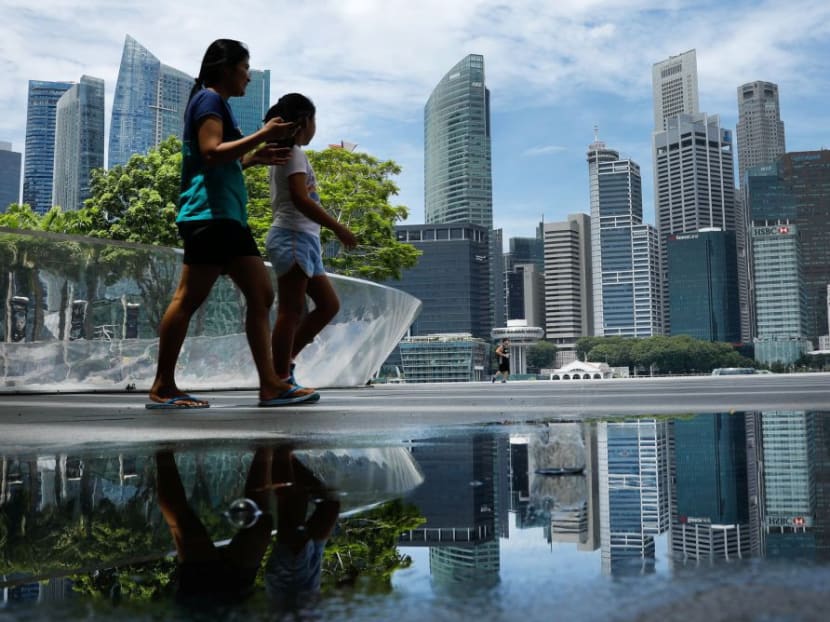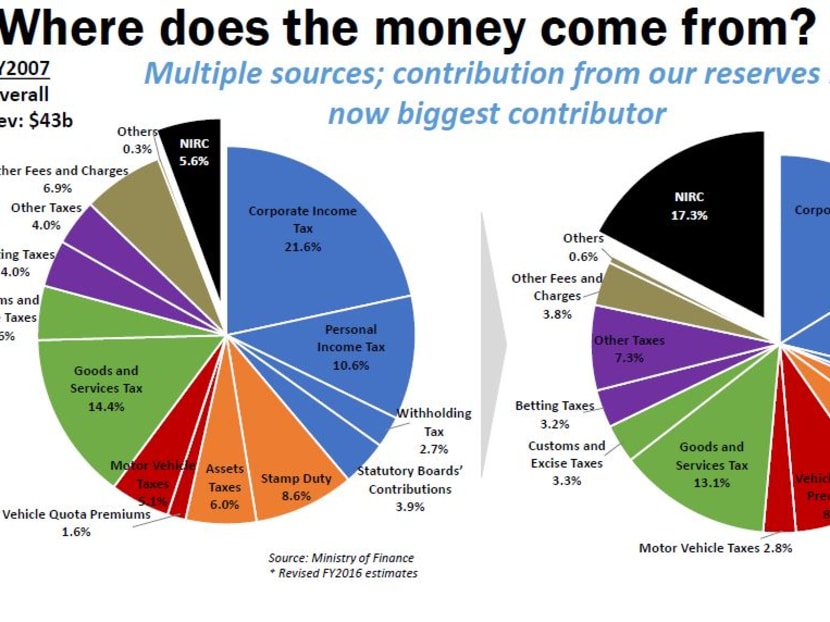Pressures on main revenue sources prompt Govt to look for ways to grow the pie
SINGAPORE — Within a decade, the Government’s coffers have seen contributions from Singapore’s reserves balloon from making up less than 6 per cent of total revenue to 17.3 per cent, following changes to the net investment returns (NIR) framework which took effect in financial year 2016.

Some economists and tax experts whom TODAY spoke to said it may not be tenable for the Government to be heavily dependent on net investment returns contribution. TODAY file photo
SINGAPORE — Within a decade, the Government’s coffers have seen contributions from Singapore’s reserves balloon from making up less than 6 per cent of total revenue to 17.3 per cent, following changes to the net investment returns (NIR) framework which took effect in financial year 2016.
However, some economists and tax experts whom TODAY spoke to said it may not be tenable for the Government to be heavily dependent on net investment returns contribution (NIRC) — which would explain why Budget 2018, to be delivered by Finance Minister Heng Swee Keat on Monday (Feb 19), looks set to focus on raising revenue including taxes such as goods and services tax (GST) in order to fund rising social spending and infrastructure investment.
Between FY2007 and FY2016, Singapore’s revenue has grown from S$43 billion to S$83 billion, based on revised FY2016 estimates. Over the same period, however, government expenditure has more than doubled from S$33 billion to S$71 billion.
Much has been said about the Government's need to raise revenue to meet rapidly rising expenditure. However, last December, Mr Heng flagged the risks to traditional revenue sources brought on by technological disruptions and changing business models. While he did not elaborate, he stressed the need for Singapore to preserve fiscal sustainability and keep the country’s revenue base diversified.
The experts told TODAY that several of Singapore’s main sources of revenue — namely personal income taxes, corporate taxes, GST and vehicle quota premiums — could come under strain if nothing is done, due to an ageing population, the e-commerce boom, and a zero vehicle growth policy which kicked in this month.

While SIM Global Education senior lecturer Tan Khay Boon noted that the zero growth policy could also restrict motor tax revenue in the future, UOB economist Francis Tan pointed out that vehicle quota premiums and motor taxes serve as a control mechanism to ensure that vehicle growth rates do not spiral out of control, rather than as a significant source of revenue. “They are primarily imposed to nudge people towards certain behaviours,” he said.
In FY2016, vehicle quota premiums and motor taxes contributed 11.1 per cent (or S$9.21 billion) to government coffers, compared to 6.7 per cent (or S$2.88 billion) in FY2007.
PERSONAL TAXES ‘MOST AT RISK’
The experts expect personal income taxes to be most adversely affected in the coming years, due to the Republic’s greying population and low fertility rates.
As of last year, the number of seniors aged 65 and above is below 570,000, and for those aged below 15 is under 700,000, based on Government statistics. The size of the former group is expected to jump to 900,000 by 2030.
Data from the Ministry of Finance (MOF) showed that personal income tax contributed 12.6 per cent, or S$10.46 billion, to the coffers in FY2016, compared to 10.6 per cent, or S$4.56 billion a decade ago.
However, as seniors drop out of the workforce and “if tight immigration controls are to be maintained, there will be a smaller pool of working adults from which income taxes can be derived”, said Mr Francis Tan.
He noted that projections on future contributions from personal income taxes will be tricky, give that are various factors involved, such as any changes to re-employment age — raised from 65 to 67 in July last year — and immigration policies.
Nevertheless, even if the seniors seek re-employment, or take on other part-time jobs, they will probably be drawing lower wages which contribute less to income tax, said Mr Francis Tan.
“Some of their income may not even be over the taxable limit,” he added. Residents whose annual income is less than S$22,000 do not need to pay tax.
Singapore’s ageing population has a “double whammy impact” on its fiscal position, said Mr Harvey Koenig, a tax partner at audit firm KPMG Singapore.
While on one hand, Singapore will increase spending on healthcare as well as infrastructure to provide for more elderly-friendly facilities, the ageing workforce will “shrink the already narrow income tax base further”, said Mr Koenig.
“This double whammy impact on expenditure and revenues means that the gap between spending and revenue could grow even faster,” he said.
Apart from the workforce’s changing demographic profile, the nature of work due to technological and economic disruptions could also have an impact.
Mr Koenig said: “The kind of investments Singapore attracts will require a different profile of jobs — higher-skilled, higher-value jobs in higher-technology industries — but lower number of new jobs overall. (This) may have an impact on personal tax collections in future, and limit Singapore’s ability to raise taxes in these areas.”
EXTERNAL DEVELOPMENTS, RISE OF BORDERLESS COMMERCE
The experts were mixed on how much risk corporate tax — traditionally Singapore’s largest source of revenue, until it was overtaken by NIRC for the first time in FY2016 — will be exposed to, amid slower domestic growth and external developments.
Corporate income taxes contributed 16.2 per cent, or S$13.45 billion, to the Republic’s operating revenue in FY2016. In FY2007, the proportion was 21.6 per cent, amounting to S$9.29 billion.
Dr Tan Khay Boon and Mr Koenig agreed that it will be increasingly challenging for the Republic to raise revenues via corporate taxes, especially when major economies such as the United States have been lowering corporate tax rates. Last November, US lawmakers unveiled a plan to slash federal corporate tax rate from 35 per cent to 21 per cent, in the largest changes to US tax laws since the 1980s. While the cut could boost investment flows into the US, whether it may prompt American companies to re-evaluate their investments here remains to be seen, the experts noted.
The corporate income tax rate in Singapore for local and foreign companies has been fixed at 17 per cent since 2010. For resident firms, it is levied on profits derived here as well as on foreign soil.
“As countries compete for foreign investments by reducing their corporate tax rates… It will be increasingly challenging for Singapore to attract foreign investments. If there are fewer foreign companies operating in Singapore, it will result in less corporate tax revenue,” said Dr Tan Khay Boon.
It is unlikely that the Government would pull the corporate and personal tax levers to boost its revenues, added Mr Koenig, lest global talent decides to re-locate themselves in places such as Hong Kong.
At the same time, the rise of e-commerce affects the profits of traditional brick and mortar retailers, said Dr Tan Khay Boon. “However, (it) can also supplement the revenues of companies that invest in it and can help to improve business efficiency and enhance profit,” he said. “The impact depends on whether the e-commerce is a complement or substitute to the company’s operations. The main issue with e-commercie lies on its impact on GST.”
Currently, online purchases of less than S$400 in value are exempt from the 7 per cent GST.
Last November, Senior Minister of State (Finance and Law) Indranee Rajah said the Government was looking at widening levies on e-commerce to broaden its tax base.
A 2016 report by Internet giant Google and Singapore state investment firm Temasek Holdings had projected that within a decade, the size of Singapore’s e-commerce market will grow more than five times to US$5.4 billion (S$7.1 billion).
Last month, the business community here urged the Government to impose a tax on e-commerce to “level the playing field”. The call was backed by a KPMG report which said such a move makes “for far better math” compared with raising GST across the board.
GST made up 14.4 per cent (or S$6.2 billion) of government revenue in FY2007, and 13.1 per cent (or S$10.9 billion) in FY2016.
While the fast-growing e-commerce sector could be a lucrative source of future tax revenue, experts had previously pointed out the myriad of challenges that governments around the world have to grapple with, including the difficulty of enforcing the tax regime and collection.
Overall, Mr Francis Tan felt the Government’s collection from corporate taxes “may not be as adversely affected” compared with the other sources of tax revenues, “if firms continue to be outward-looking and look at deriving profits from their businesses in other countries”.
CONTRIBUTION FROM RESERVES
Recent changes to the NIR framework allowed the Government to spend up to half of the long-term expected real returns from the assets managed by GIC, the Monetary Authority of Singapore and Temasek Holdings.
While reserves are currently the largest contributor to Singapore’s operating revenue, Singapore University of Social Sciences labour economist Randolph Tan cautioned that such heavy reliance on the NIRC as government spending grows is a “very insecure arrangement”, due to the uncertainty over whether the growth will keep in pace with the Republic’s future needs.
“One of the main risks from the heavy reliance on NIRC is the failure to take into account fluctuations in returns due to increasing market volatility,” said Assoc Prof Randolph Tan, who is also a Nominated Member of Parliament.
While the full size of Singapore’s financial reserves has never been revealed for strategic reasons, it is estimated at more than S$1 trillion.
Dr Tan Khay Boon agreed that the “risk of being over-dependent on NIRC exists”, even though the track record shows that GIC and Temasek Holdings have been able to generate reasonable returns over a long period of time.
“If the external environment remains conducive to trade and investment, the revenue from NIRC appears to be a stable source…The returns also depend on the market performance which tends to fluctuate. In addition, risk and returns are positively related which means higher risks are needed to generate higher returns,” he said.
Amid the challenges facing Singapore’s main sources of revenue, the Government is looking at ways to boost its coffers in order to fund rising expenditure, with many expecting a GST hike to be announced in Monday’s Budget statement.
Nevertheless, the experts noted that the GST is not the only lever which the Government can pull. Among other things, it could reduce income tax ceilings for various tax brackets, such as lowering the threshold for annual incomes taxed at the highest rate of 22 per cent from the current S$320,000 to S$300,000, Mr Francis Tan suggested.
The property market, which is roaring back to life, is also a potential source of additional revenue.
Mr Koenig said the Government could “consider tweaking the property tax system to achieve even greater progressivity and raise more revenue in the process”.
Dr Tan Khay Boon proposed allowing revenues from government land sales, which currently form part of the Republic’s reserves, to be used in government spending. However, he cautioned that this “may result in undesirable consequences and it is also not sustainable in a land-scarce country like Singapore”.
The Republic’s Constitution forbids revenue from land sales to be budgeted for spending to avoid a situation where the Government of the day sells land in order to meet their expenditure needs.
Ultimately, any long-term solution to Singapore’s fiscal sustainability must involve a multi-pronged approach. “This includes maintaining a diverse source of revenue, ensuring a healthy and well-functioning economy, and keeping a wide taxpayer base,” said Mr Koenig.






